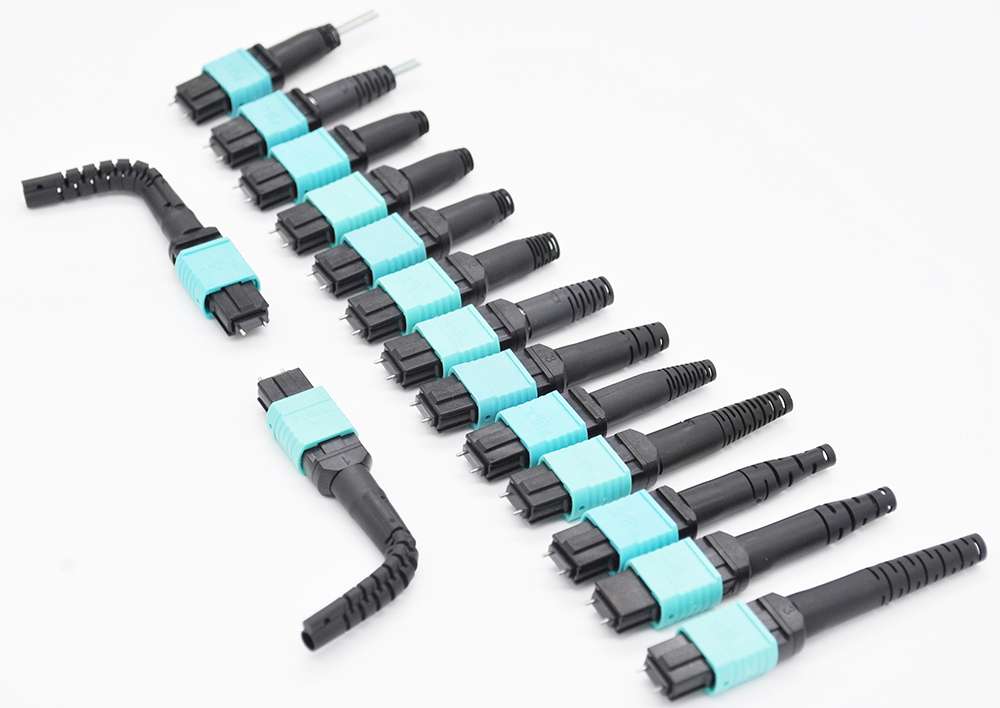The plugging life of MTP connectors varies significantly due to differences in technology and process. The MPO fiber connector types are divided into traditional mechanical contact MTP fiber connector and non-contact MTP optical connector.
1. Traditional mechanical contact MTP connectors
Standard MPO: The typical plugging and unplugging life is 500 times. After exceeding this number, the end face near the guide hole is prone to obvious damage, affecting the optical performance.
Improved MTP (MPO upgraded version): By optimizing the spring structure and guide pin fixing clip design, the life is increased to 600 times, and the end face is still basically intact after plugging and unplugging.

2. Non-contact innovative MPO technology
This MPO technolody adopting a design without physical end face contact, the plug-in life can reach 5000 times, and it is not sensitive to dust, and the repeated insertion loss is ≤0.01dB, suitable for test environments with high reliability requirements or cutting-edge equipment (such as silicon photonic chip interconnection).
3. The comparison of MTP connector plug-in life as below
| Type | Plug and unplug life | Core advantages | Limitations |
| Traditional MPO | 500 times | Low cost, widely used in commercial applications | Easy to wear, requires frequent maintenance |
| Improved MTP | ≥600 times | Strong wear resistance, better end face protection | High price |
| Non-contact MPO (experimental grade) | 5000 times | Ultra-long life, almost maintenance-free | Extremely high cost, limited application |
4. Key reasons for life reduction
Mechanical wear: repeated plugging and unplugging causes friction between the guide pin and the sleeve, resulting in end face scratches (the main failure mode of traditional MPO);
Spring fatigue: reduced spring tension causes fiber docking to shift, increasing insertion loss;
Pollution sensitivity: dust intrusion will accelerate end face damage, especially for mechanical contact designs.
5. Buying advice
- Conventional data centers choose MTP connectors (600+ lifespans) based on balancing cost and reliability;
- High maintenance difficulty scenarios (such as submarine optical cables, space equipment) can explore non-contact MPO solutions;
Strict clean the end face regularly and monitor insertion loss, and replace it when the lifespan approaches 500 times.

FAQ
How to extend the plug-in and pull-out life of MPO connectors?
- Make sure that the connector guide pin is completely parallel and vertical to the sleeve during plug-in and pull-out, control the plug-in and pull-out force, and stop applying force when you hear a click sound, which can reduce 90% of the mechanical damage to the end face.
- It is recommended to use MTP instead of MPO connectors, which can increase the life from 500 times to more than 600 times.
- At the same time, clean the connector end face regularly to delay oxidation wear and maintain insertion loss ≤0.7dB (Elite ≤0.35dB).
- In addition, pay attention to wearing dust caps and controlling environmental humidity to reduce the sudden failure rate caused by pollution by 70%.
What is the difference between MTP connector and MPO connector?
- Compared with MPO connector, the spring design of MTP connector can maximize the space for ribbon fiber, thereby reducing the damage to the fiber caused by spring activity during plugging and extending the service life of the connector.
- After 600 plugging and unplugging, the end face near the guide hole of MTP optical connector is basically intact, while after more than 500 plugging and unplugging of MPO fiber connector, the end face near the guide hole will be obviously damaged.
- The guide pin fixing clip designed by fiber MTP connector can effectively fix the guide pin to prevent it from falling off and losing, and the MTP ferrule can float in the outer shell frame, which improves the mechanical performance.
How to determine whether the MPO connector needs to be replaced?
First, check whether the surface of the MPO connector is cracked, deformed, twisted, rusted, or corroded. If it is serious, recommended to replace it.
In addition, use the OTDR to measure the insertion loss and return loss. If the value is too large, it may need to be replaced.
Finally, please regularly check and replace the old connectors according to the number of plug-in and unplug times, working environment, and usage time and frequency.

